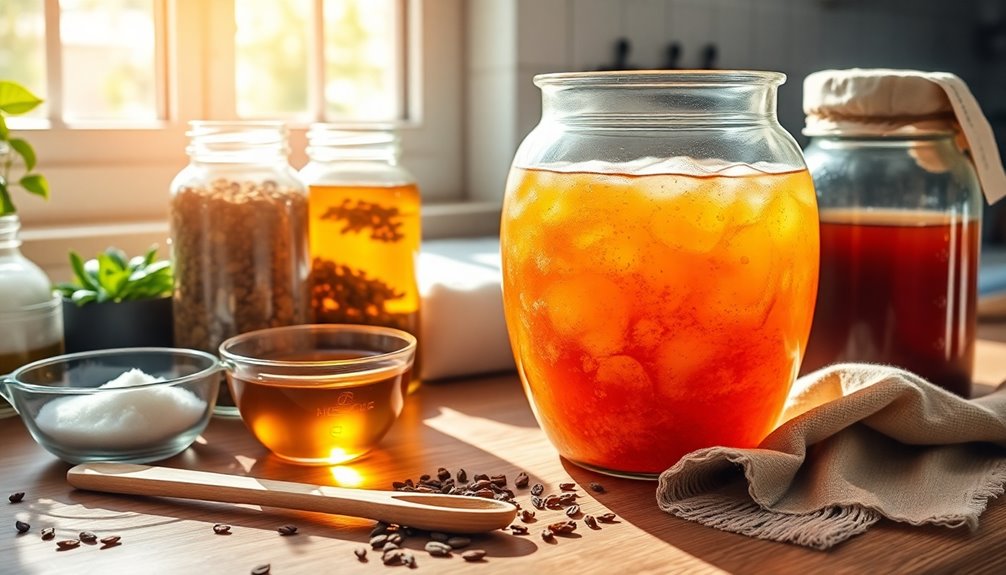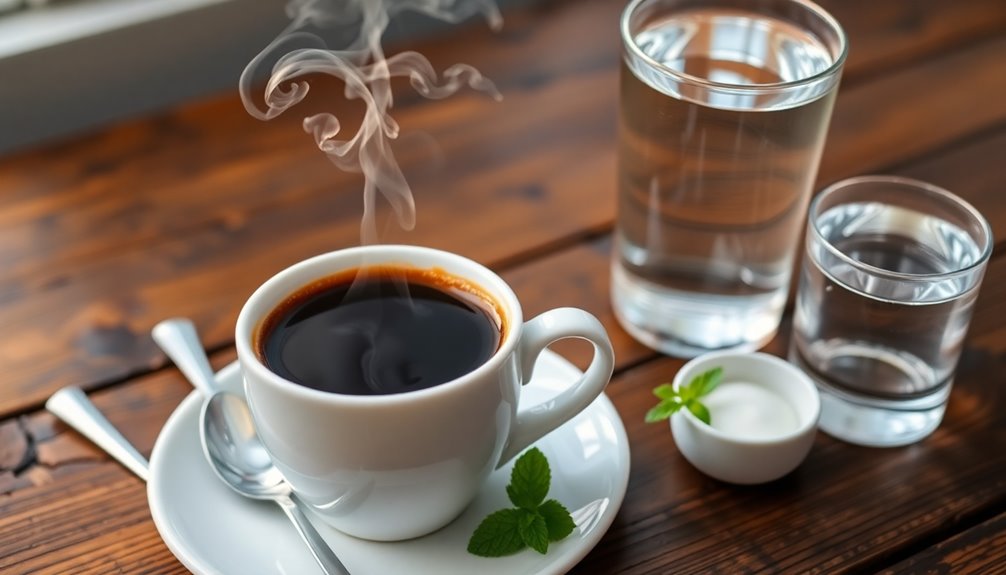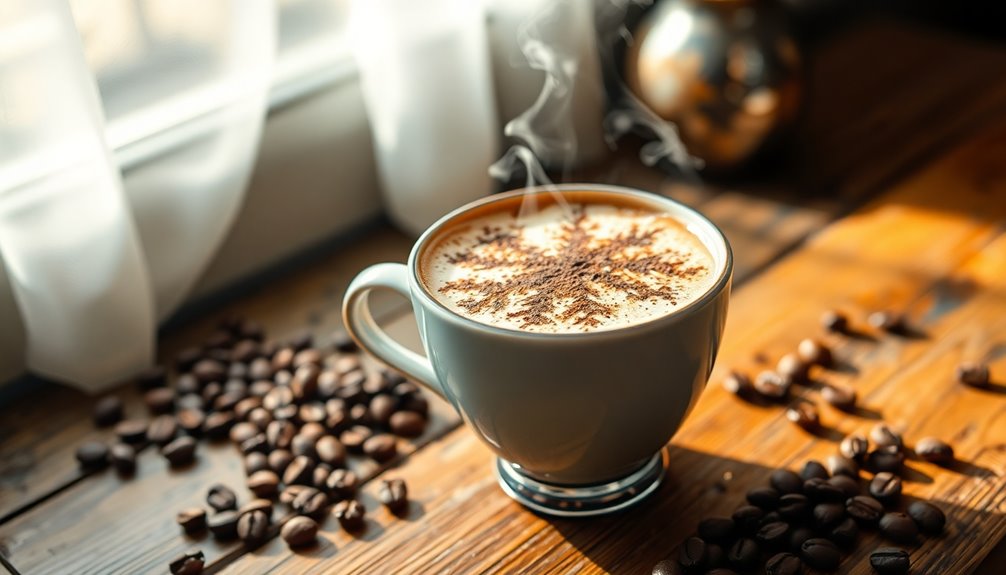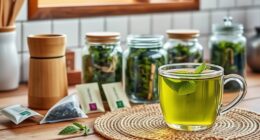The art of coffee roasting is an exciting journey through various roast levels, each one offering distinct flavors and aromas. You experience light roasts that showcase brightness, while medium roasts provide a balance of acidity and body. As you explore further, medium-dark and dark roasts introduce richer, bolder flavors with deep notes. Factors like origin, moisture content, and roasting temperature greatly influence the final taste. Different roasting methods, from drum to fluid bed roasting, help you control taste profiles efficiently. By understanding these elements, you can enhance your coffee experience and discover your perfect cup of joe. There's much more to uncover!
Key Takeaways
- Coffee roasting involves multiple stages, including drying, roasting, development, and cooling, each crucial for flavor development and quality.
- Different roasting methods, such as drum, pan, and hot air roasting, influence the final taste and characteristics of the coffee.
- The origin and variety of coffee beans significantly impact their flavor profiles, showcasing unique notes from different regions.
- Roasting temperatures and durations determine the roast type—light, medium, medium-dark, or dark—each offering distinct taste experiences.
- Monitoring techniques like NIR spectroscopy and cupping ensure consistency and help identify desired flavor characteristics during the roasting process.
The Coffee Roasting Process

When you roast coffee, you engage in a fascinating process that transforms green beans into the aromatic, flavorful coffee you enjoy.
It begins with the drying stage, where beans, containing about 10% humidity, are heated to around 160°C (212°F) for 4-8 minutes, turning them from green to yellow. This stage is essential for removing moisture from the beans before they enter the main roasting phase.
Next comes the roasting stage, where temperatures between 200-230°C (392-446°F) develop the beans' flavors, leading to the crucial first crack.
During the development stage, beans caramelize and release essential compounds, with timing affecting the roast level.
Finally, you cool the beans quickly to halt the cooking process, preserving their unique flavors.
This careful balance of temperature and time is essential for achieving the perfect roast you crave.
Methods of Coffee Roasting

Coffee roasting boasts a variety of methods, each offering unique flavors and characteristics to your brew. From the light and fruity notes of a light roast to the rich and bold flavors of a dark roast, the spectrum of coffee roasts allows for endless experimentation and customization. Whether you prefer a bright, tangy acidity or a smooth, chocolatey finish, there is a roast out there to suit every palate. Some roasters even specialize in creating custom blends that combine different roasts to achieve a specific flavor profile.
You can choose traditional techniques like drum roasting, which provides consistent results and a range of flavors. Open-fire roasting brings a distinct taste influenced by fuel type, while pan roasting allows for artisanal control. Stovetop roasting offers quick experimentation at home, though it can be inconsistent. Additionally, traditional methods often result in variability in results due to the manual techniques involved.
Modern methods include hot air roasting, known for precise temperature control and clean flavors. Fluid bed roasting suspends beans in hot air, ensuring uniformity and bright acidity. Infrared roasting lets you manipulate flavors precisely, and high heat roasting delivers intense, smoky profiles.
Each method shapes your coffee experience, so explore them to find your favorite!
Factors Affecting Roast Quality

While many factors contribute to the quality of a coffee roast, the origin and variety of green coffee beans play a crucial role. Different regions yield beans with distinct flavor profiles, and high-quality beans often come from renowned areas like Ethiopia, Colombia, and Costa Rica.
The genetic makeup of the coffee plant significantly impacts flavor and aroma, influenced further by the soil, climate, and altitude of the growing region. Additionally, roasting temperature and duration are vital; lower temperatures preserve unique flavors, while the right duration helps achieve the desired roast level. The moisture content during roasting also plays a critical role in preventing off-flavors and ensuring even roasting.
Lastly, maintaining proper moisture content ensures even roasting and prevents off-flavors. Each of these elements intertwines, shaping the final quality of your coffee roast.
Types of Coffee Roasts

Understanding the different types of coffee roasts can greatly enhance your coffee experience.
Light roasts are roasted at lower temperatures, resulting in a bright, acidic flavor that showcases the coffee's origin. Green coffee beans lack color and aroma prior to roasting, which makes the roasting process essential for unlocking the unique characteristics of the beans.
Medium roasts strike a balance between acidity and body, offering a richer taste with some oil on the beans.
If you enjoy a bolder flavor, medium-dark roasts provide a fuller body and more robust taste, often showing more oils.
Finally, dark roasts, roasted past the second crack, deliver a smoky, rich flavor with minimal acidity, dominating the palate with deep, bold notes.
Each roast type brings unique characteristics, allowing you to explore and find your perfect cup.
Monitoring the Roast

To achieve the perfect roast, monitoring is crucial throughout the process. Utilizing NIR spectroscopy, you can measure moisture content and color in real-time, ensuring consistency and high-quality results. This technology helps you reduce operating costs while meeting customer expectations. Moreover, employing NIR-Online Process Analyzer allows for continuous data collection, facilitating precise adjustments during the roasting process.
Alongside this, visual inspection and aromatic analysis play vital roles. Pay attention to the beans' color and aroma to detect desired notes like caramel or chocolate. Cupping techniques enable you to analyze taste accurately, and using the Coffee Taster's Flavor Wheel can help categorize flavors effectively.
Additionally, employing temperature monitoring systems and tracking the rate of rise (RoR) allows for precise control, making every batch a testament to your dedication to coffee roasting excellence.
Frequently Asked Questions
How Does the Origin of Coffee Beans Affect Flavor?
The origin of coffee beans plays a crucial role in shaping their flavor profile.
When you explore beans from different regions, you'll notice unique characteristics influenced by climate, soil, and altitude.
For instance, Ethiopian beans often deliver floral and fruity notes, while Brazilian varieties lean towards nutty and sweet flavors.
What Equipment Do I Need for Home Coffee Roasting?
To start home coffee roasting, you'll need a coffee roaster, which can be air or drum type.
A thermometer and timer help monitor temperature and roasting time, ensuring consistent results.
Don't forget a cooling tray to halt the roasting process quickly.
A scale measures green beans accurately for consistent batches.
Safety features like smoke filters and automatic cooling cycles are essential too, so you can roast with confidence and ease.
Can I Roast Coffee Beans in My Oven?
Yes, you can roast coffee beans in your oven! Preheat it to around 250℃ and use a perforated baking tray for even roasting.
Spread the beans evenly, avoiding overlap, and monitor them through the oven window. Keep stirring to a minimum to maintain heat.
Watch for the first crack around 7-9 minutes, then remove the beans when they reach your desired roast level. Let them cool and rest for optimal flavor!
How Should I Store Roasted Coffee Beans?
To store roasted coffee beans, use airtight containers made of glass, ceramic, or stainless steel.
Avoid plastic, as it can trap odors. Keep them in a cool, dark place, away from heat and sunlight, to preserve flavor.
For long-term storage, consider freezing the beans in an airtight container, but only take out what you need for a week to maintain freshness.
Always label your containers with the roast date for easy reference.
What's the Ideal Grind Size for Different Roast Levels?
When choosing the ideal grind size for your coffee, think about the roast level.
For light roasts, go for a finer grind to enhance those bright flavors.
Medium roasts need a medium-fine grind, striking a balance between sweetness and acidity.
Dark roasts benefit from coarser grinds, reducing bitterness.
Always adjust your grind size based on your brewing method and remember, the right grind can make all the difference in your cup!
Conclusion
In your journey through the art of coffee roasting, you've uncovered the nuances that make each roast unique. By understanding the roasting process, experimenting with different methods, and considering the factors that impact quality, you can elevate your coffee experience. Whether you prefer a light, medium, or dark roast, the key is to monitor your beans closely. Embrace the exploration, and you'll find the perfect roast that resonates with your taste buds. Happy roasting!










